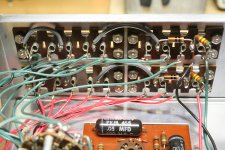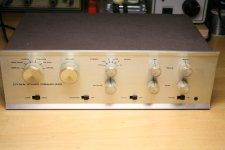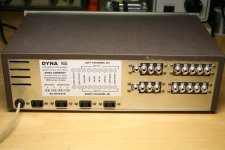I powered it up slowly plugged into a home-made dim-bulb tester which is plugged into a variac/isolation transformer. No sparks, smoke, etc.
Taking readings with a multimeter here is what I come up with (the first measurement is reprinted from the PAS Voltage Chart)
PINS
12X4
1_____(335 V AC) 330 V
2_____(0) 0
3-4___(10.5 V AC) 10.3 V
5_____(0) 0
6_____(335 V AC) 330 V
7_____(405 V DC) 390 V
12AX7 / 12AX7 (PC-5)
1_____(175 V DC) 151 V / 153 V
2_____(0) 0 / 0
3_____(1.45 V DC) 1.5 V / 1.46 V
4_____(LESS THAN 1 V) .2 V / .3 V
5_____(+- 11 V DC) -11.4 V / +11.5 V
6_____(200 V DC) 178 V / 183 V
7_____(0) 0 / 0
8_____(1.25 V DC) 1.29 V / 1.2 V
9_____(+- 5.5 V DC) -5.7 V / +5.7 V
12AX7 / 12AX7 (PC-6)
1_____(115 V DC) 94 V / 96 V
2_____(0) 0 V / 0 V
3_____(.7 V DC) .65 V / .68 V
4_____(0) 0 V / .005 V
5_____(+- 11 V DC) +11.5 V / -11.5 V
6_____(135 V DC) 117 V / 116 V
7_____(0) -.09 V / -.04 V
8_____(.8 V DC) .75 V / .76 V
9_____(+- 5.5 V DC) +5.68 V / -5.7 V
Taking readings with a multimeter here is what I come up with (the first measurement is reprinted from the PAS Voltage Chart)
PINS
12X4
1_____(335 V AC) 330 V
2_____(0) 0
3-4___(10.5 V AC) 10.3 V
5_____(0) 0
6_____(335 V AC) 330 V
7_____(405 V DC) 390 V
12AX7 / 12AX7 (PC-5)
1_____(175 V DC) 151 V / 153 V
2_____(0) 0 / 0
3_____(1.45 V DC) 1.5 V / 1.46 V
4_____(LESS THAN 1 V) .2 V / .3 V
5_____(+- 11 V DC) -11.4 V / +11.5 V
6_____(200 V DC) 178 V / 183 V
7_____(0) 0 / 0
8_____(1.25 V DC) 1.29 V / 1.2 V
9_____(+- 5.5 V DC) -5.7 V / +5.7 V
12AX7 / 12AX7 (PC-6)
1_____(115 V DC) 94 V / 96 V
2_____(0) 0 V / 0 V
3_____(.7 V DC) .65 V / .68 V
4_____(0) 0 V / .005 V
5_____(+- 11 V DC) +11.5 V / -11.5 V
6_____(135 V DC) 117 V / 116 V
7_____(0) -.09 V / -.04 V
8_____(.8 V DC) .75 V / .76 V
9_____(+- 5.5 V DC) +5.68 V / -5.7 V
Last edited:
Really good, and you have the later machined aluminum knobs, instead of the cast ones.
Really good, and you have the later machined aluminum knobs, instead of the cast ones.
Thanks. Yes, I just noticed the difference between the PAS knobs and those on my FM3 which have sharper edges.
Been listening to the PAS for a couple of hours now. It's very quiet except when switching to and from PHONO and TAPE HEAD, there is a pronounced "thump" when doing so.
That's what happens when the eq feedback components are hot switched. Most would not need to do that.
It's best for current users to relocate all the RIAA parts to the board, which gives 3 phono inputs instead
of a mic, a tape head, and a phono input.
It's best for current users to relocate all the RIAA parts to the board, which gives 3 phono inputs instead
of a mic, a tape head, and a phono input.
Last edited:
The hump when switching to phono comes from the exit caps on the phono board, they have no load whatsoever when not selected. Thus they may (and can) discharge the exit caps leaving the output a few volt above ground.Thanks. Yes, I just noticed the difference between the PAS knobs and those on my FM3 which have sharper edges.
Been listening to the PAS for a couple of hours now. It's very quiet except when switching to and from PHONO and TAPE HEAD, there is a pronounced "thump" when doing so.
A resistor of 470k mounted at the underside of the board will keep them at ground voltage. ( eyelet 1 and 7 on PC 6)
This shows how good those "black cats" really are.
Last edited:
That's what happens when the eq feedback components are hot switched. Most would not need to do that.
It's best for current users to relocate all the RIAA parts to the board, which gives 3 phono inputs instead
of a mic, a tape head, and a phono input.
Can the "Tape Head" input be converted to "Line Level" ?
The hump when switching to phono comes from the exit caps on the phono board, they have no load whatsoever when not selected. Thus they may (and can) discharge the exit caps leaving the output a few volt above ground.
A resistor of 470k mounted at the underside of the board will keep them at ground voltage. ( eyelet 1 and 7 on PC 6)
This shows how good those "black cats" really are.
I don't plan on using the "Tape Head" or "Special" inputs as-is so the noise won't be a problem but I would consider converting the "T-H" to something more useful if possible.
Last edited:
Can the "Tape Head" input be converted to "Line Level" ?
I don't think the Dyna selector switch can do that. Unless you replace it with a more standard switch,
about all you can do is have three phono inputs, by not switching the eq parts.
I don't think the Dyna selector switch can do that. Unless you replace it with a more standard switch,
about all you can do is have three phono inputs, by not switching the eq parts.
I see, I don't need another phono input so I'll just stay away from that part of the dial.
I have a couple more PAS preamps that need work, one of which I intend to do some mods to so will probably get a new selector switch while I'm at it.
In that case, mount the two 750pF capacitors directly on the board, where the wires from the switch usually go.
Also, wire the two phono inputs directly to the board, using twisted pairs.
Also, wire the two phono inputs directly to the board, using twisted pairs.
Last edited:
Also silicon diodes for the filaments, and film caps instead of electrolytics for the output caps.
New volume control is necessary for current standards. There are replacement boards for
the RCAs so you can use better quality jacks.
Update My Dynaco Store
New volume control is necessary for current standards. There are replacement boards for
the RCAs so you can use better quality jacks.
Update My Dynaco Store
Last edited:
If you prefer different RCA jacks, you can make your own mounting boards pretty easily.
A punch helps a lot, though.
A punch helps a lot, though.
- Home
- Amplifiers
- Tubes / Valves
- Dynaco PAS 3X Re-Build



